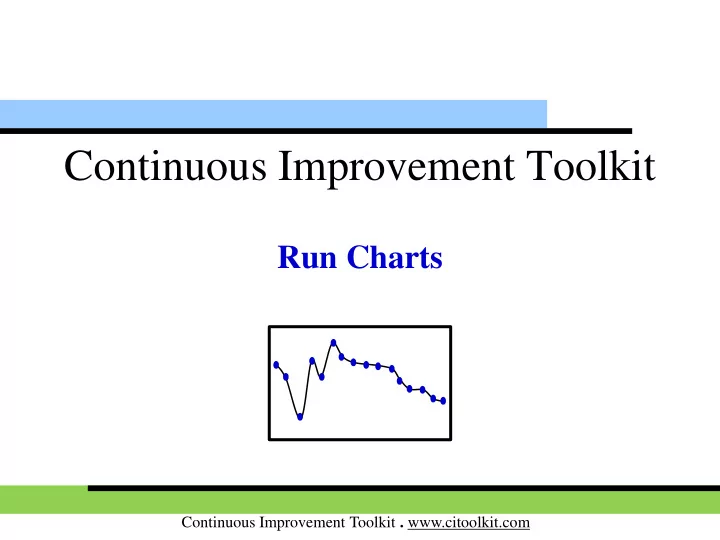

Continuous Improvement Toolkit Run Charts Continuous Improvement Toolkit . www.citoolkit.com
Managing Deciding & Selecting Planning & Project Management* Pros and Cons Risk PDPC Importance-Urgency Mapping RACI Matrix Stakeholders Analysis Break-even Analysis RAID Logs FMEA Cost -Benefit Analysis PEST PERT/CPM Activity Diagram Force Field Analysis Fault Tree Analysis SWOT Voting Project Charter Roadmaps Pugh Matrix Gantt Chart Decision Tree Risk Assessment* TPN Analysis Control Planning PDCA Matrix Diagram Gap Analysis QFD Traffic Light Assessment Kaizen Prioritization Matrix Hoshin Kanri Kano Analysis How-How Diagram KPIs Lean Measures Paired Comparison Tree Diagram** Critical-to Tree Standard work Identifying & Capability Indices OEE Pareto Analysis Cause & Effect Matrix TPM Simulation Implementing RTY MSA Descriptive Statistics Understanding Confidence Intervals Mistake Proofing Solutions*** Cost of Quality Cause & Effect Probability Distributions ANOVA Pull Systems JIT Ergonomics Design of Experiments Reliability Analysis Hypothesis Testing Graphical Analysis Work Balancing Automation Regression Scatter Plot Understanding Bottleneck Analysis Correlation Run Charts Visual Management Performance Chi-Square Test Multi-Vari Charts Flow 5 Whys 5S Control Charts Value Analysis Relations Mapping* Benchmarking Fishbone Diagram SMED Wastes Analysis Sampling TRIZ*** Focus groups Brainstorming Process Redesign Time Value Map Interviews Analogy SCAMPER*** IDEF0 SIPOC Photography Nominal Group Technique Mind Mapping* Value Stream Mapping Check Sheets Attribute Analysis Flow Process Chart Process Mapping Measles Charts Affinity Diagram Surveys Data Visioning Flowcharting Service Blueprints Lateral Thinking Critical Incident Technique Collection Creating Ideas** Designing & Analyzing Processes Observations Continuous Improvement Toolkit . www.citoolkit.com
- Run Charts A run chart is a plot of data overtime. It is a line graph of data points plotted in chronological order. These data points represent measurements, counts, or percentages of process output. It is a quick and easy approach of deciding if the process is stable. It highlights signals of special causes of variation in a process such as trends and patterns. Continuous Improvement Toolkit . www.citoolkit.com
- Run Charts Used to monitor changes that occur within a process. A completed chart can show if an implemented improvement idea was successful. The horizontal axis shows the order of the data were collected. The vertical axis shows the data values. Used to visualize the process overtime without regard to specification limits. Continuous Improvement Toolkit . www.citoolkit.com
- Run Charts It often uses the median to show the central location. Run charts are similar in some regards to the control charts. It doesn’t show the control limits of the process. They are therefore simpler to produce. However, they do not allow for the full range of analytic techniques supported by control charts. Continuous Improvement Toolkit . www.citoolkit.com
- Run Charts Shifts: • When you see a number of consecutive points on one side of the center line. Trends: • When you see a number of consecutive points in the same direction (up or down). Patterns: • When you see a pattern that recurs a number of times in a row. Continuous Improvement Toolkit . www.citoolkit.com
- Run Charts A Run Exists When: A number of consecutive points lie on one side of the median. A number of consecutive data points that all increase or decrease. A pattern recurs a number of times in a row. A Shift A Trend Continuous Improvement Toolkit . www.citoolkit.com
- Run Charts Is there a significant trend or pattern that should be investigated? Repeating Pattern Continuous Improvement Toolkit . www.citoolkit.com
- Run Charts Tips: You need to have 25 points or more in your data series. A long run might be a signal of: • A special cause variation. • A beginning of a common cause shift. • An improvement in the process. Whether or not a run is significant depends on the number of data points plotted. Run charts can also be used to track improvements that have been put into place, checking their success. Continuous Improvement Toolkit . www.citoolkit.com
Recommend
More recommend